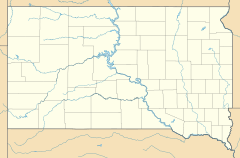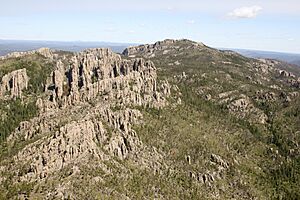Bismuth, South Dakota facts for kids
Quick facts for kids
Bismuth, South Dakota
|
|
|---|---|
| Country | |
| State | |
| County | Custer |
| Elevation | 4,472 ft (1,363 m) |
| Time zone | UTC-7 (MST) |
| • Summer (DST) | UTC-6 (MDT) |
Bismuth is a ghost town located in the Black Hills of Custer County, South Dakota, United States. A ghost town is a place where most people have left, leaving behind empty buildings and a quiet history.
Contents
History of Bismuth
Before the Town Existed
The land around Bismuth was once important hunting and sacred ground. It was used by several Native American groups. These included the Western Sioux, Cheyenne, Kiowa, and Arapaho peoples.
In 1868, a special agreement called the 1868 Treaty of Fort Laramie was made. This agreement said that the Black Hills belonged to the Sioux and Arapaho. But in 1874, a military group led by George Custer found gold there. This discovery started the Black Hills Gold Rush. Thousands of new settlers came to the area.
Native American groups tried to protect their lands. This led to conflicts, including the Black Hills War in 1876. Even though Native Americans won a famous battle called the Battle of the Little Bighorn, the Black Hills War ended with the Sioux giving up their rights to the Black Hills in 1877. The land then became part of the United States government.
The gold rush and the change in land ownership led to many new towns. These were often called boomtowns because they grew very quickly. Mines and other settlements appeared, and Bismuth was one of them. A very famous example was the Homestake Mine in Lead, South Dakota. It was the biggest gold mine in the Western Hemisphere before it closed in 2002.
Life in Bismuth
Bismuth was a small community around 1901. It had about six homes. There was also a store and even a baseball team. By 1974, only one old house was left. Today, it's not known if any buildings are still standing. The area where Bismuth once stood is now a wildlife preserve and has a man-made lake.
Why the Name Bismuth?
The town of Bismuth was named after the metal bismuth. This metal is the 83rd element on the periodic table. You can find it naturally in the Earth's crust. Bismuth is used to make medicines, cosmetics, and other industrial products.
It's a bit of a mystery why the town was named Bismuth. While bismuth is mined in the United States, there are no records of it ever being mined in South Dakota.
Where Was Bismuth?
Bismuth was located in the Black Hills National Forest. It was on the eastern edge of the Black Elk Wilderness. Today, the exact spot is part of Lakota Lake in Custer County.
Bismuth was about 1.5 miles northwest of another ghost town called Spokane. It was also about five miles southeast of the famous Mount Rushmore.
Nature and Wildlife
The area around Bismuth, like much of the Black Hills, is home to many different plants and animals. You can find species usually seen in the Rocky Mountains, the Great Plains, northern boreal forests, and eastern deciduous forests.
The most common tree here is the Ponderosa pine. But you can also see spruce, aspen, birch, and oak trees. There are many white-tailed deer and mule deer. A smaller number of elk also live here.
Seeing a mountain lion is rare, but you will often see coyotes. Many native bird species live in the area. These include mountain bluebirds, western tanagers, goshawks, and ospreys. Sometimes, bald eagles visit during the winter.
Bismuth Today
Not much is left of the old town of Bismuth today.
The land where Bismuth once stood is now part of the Norbeck Wildlife Preserve. This preserve is named after Peter Norbeck, a politician from South Dakota who cared a lot about nature. It was created in 1920. The preserve also includes the Black Elk Wilderness, named after Black Elk, a respected Oglala Lakota holy man.
Famous landmarks like Mount Rushmore and Black Elk Peak are also within the Norbeck Wildlife Preserve. Black Elk Peak is the highest point in South Dakota. It is also the highest point in the United States east of the Rocky Mountains.
Lakota Lake, which covers part of the old town site, is a great place for rainbow trout fishing. You can also enjoy non-motorized boating there. There is a picnic area and access to the Iron Creek Trails for hiking.



